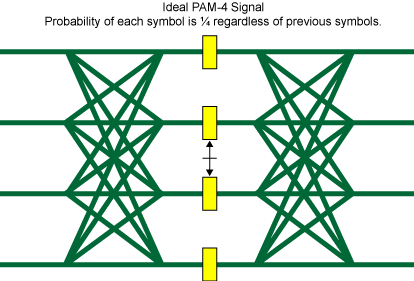VEC Result
Jitter mode's Vertical Eye Closure (VEC) is a measure of the ratio of the ideal eye opening (separation between the average levels surrounding the eye) to the measured eye height reported in dB. The higher the result (decibels) the more the eye is closed. For PAM4 signals, VEC is measured for each of the three PAM4 eyes, however the IEEE 802.3ck standard's pass or fail is based on the worst result of the three eyes (the highest value in dB).
VEC is a default measurement that is shown in the Jitter mode's results panels that is shown just below the jitter graphs. For NRZ signals, the VEC results are shown in the Amplitude panel. For PAM4 signals, the VEC results are shown in the Eye panel. If the measurement has been removed from the panel, click the Meas tab on the left side of the application, and locate and click the Reset Ampl Meas button for NRZ VEC or the Reset Eye Meas button for PAM4 VEC.
In FlexDCA's default state, the VEC measurement is IEEE 802.3ck compliant:
- Uses a measurement probability of 10-5.Use the Advanced tab of the Jitter Mode Measurement Setup dialog to specify that the measurement be based on Probability (the default value) or Symbol Error Ratio (SER). The eye height measurements specified in the latest PAM4 standards are made at probabilities instead of SER, and
- Measuring the average levels within a +/- 2.5% window (5%). This matches the Amplitude Level Width setting of 5% in the Thresholds tab of the Jitter Mode Measurement Setup dialog. You can, of course, change this setting. These setting affect how the eye height is measured and is used for both Eye Height and VEC measurements.
In the itter Mode Measurement Setup dialog's Amplitude Measurements tab you can also configure the Symbol Level Definitions field and select either Average (the default value) or Consecutive Identical Digits.
The eye height measurements specified in the latest PAM4 standards are made at probabilities instead of SER.
Probability vs. SER (PAM4 signals)
To make an VEC measurement at a probability, a Cumulative Distribution Function (CDF) is made for the top and bottom eye edges at our sampling threshold. These CDFs are the probability that a level passes through the sampling threshold anywhere between this "y" location and the eye center. The probabilities range from 0 at the eye center to 1 outside the eye. However each level only occurs a fraction of the time (the symbol density, or ¼ in this example), so the CDFs need to be scaled by ¼ to calculate the eye height at an SER. In the general case, the probability on each side of the eye (top/bottom) must be scaled by the symbol density on that side.

For example, if we are interested in the VEC at a probability of 10-6:
- The equivalent SER to search for at the top is SDtop * 10-6 (0.25 * 10-6 in this case).
- The equivalent SER to search for at the bottom is SDbottom * 10-6 (0.25 * 10-6 in this case).
The top and bottom SERs at a given probability can be different from each other.
SCPI Command
:MEASure:PEYE:VECLosure (for PAM4 signals)
:MEASure:AMPLitude:VECLosure (for NRZ signals)